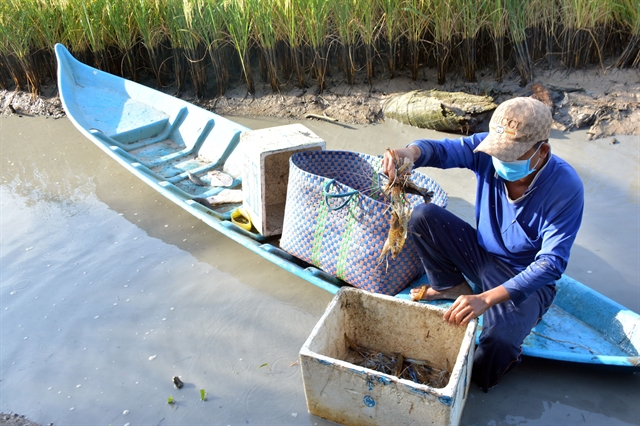
HCM CITY — The shrimp – rice farming model in the Cửu Long (Mekong) Delta will offer farmers greater benefits when all related stakeholders work together to improve its value and protect the environment, Minister of Agriculture and Rural Development Lê Minh Hoan has said.
Invented by farmers in the delta’s coastal areas years ago, shrimp – rice farming refers to breeding shrimp in the dry season and growing rice in the rainy season in the same fields.
The model is ideal for coastal areas where fields are normally affected by saltwater intrusion in the dry season, which does not allow farmers to grow rice.
Speaking at a seminar on developing the model in Bạc Liêu Province late last week, he said it enables farmers to earn steady incomes and also adapt to climate change.
The Government, scientists and companies should work together to improve the model, he said.
“The income from the model is only steady when the environment is protected well.”
The delta has huge potential for developing shrimp – rice farming, and the model has been expanded in recent years.
Both the shrimp and rice produced under it are clean since farmers use few chemicals.
In Bạc Liêu Province, the area under the model is growing at an average 5.2 per cent a year, reaching 39,400ha last year and accounting for 33 per cent of the total shrimp farming area.
Phạm Văn Thiều, chairman of the province People’s Committee, said this model fetches farmers VNĐ40 – 60 million (US$1,800 – 2,700) per hectare per year, 15 – 30 per cent more than monoculture rice.
Many companies have signed deals with farmers adopting it, he said.
But the model now faces difficulties due to climate change, rising sea levels and saltwater intrusion into rivers, according to delta authorities.
Investment for building infrastructure for irrigation, power supply and transportation is inadequate for farmers to switch from unproductive monoculture rice to shrimp – rice farming.
Many farmers lack the knowledge and resources needed to adopt advanced techniques, have small holdings and lack linkages with companies to guarantee sales of their produce.
The delta, the country’s largest producer of rice and shrimp, had nearly 189,000ha under shrimp – rice farming last year.
Farmers are growing more speciality and fragrant rice varieties like 1 bụi đỏ, OM5451, OM 2017, ST 24, and ST 25 under the model as they are resistant to salinity and offer high yields.
ST 24 and ST 25, past winners of the world’s best rice variety contests, are in high demand and fetch high earnings and so local authorities encourage farmers to grow them under the model.
The delta plans to expand the area to 200,000ha this year, according to the Directorate of Fisheries.
But seminar participants pointed out that to expand the model, incentives need to be offered and advanced farming techniques should be developed.
Nguyễn Hoàng Anh, general director of the Nam Miền Trung Aquaculture Investment Co., Ltd., said authorities should do detailed studies on output, zoning, value, and market, and share the results with localities so that they could set up their own zoning plans for developing the model sustainably.
“Competent agencies should have detailed farming schedules for the model for each crop and strictly enforce them.”
Hồ Quang Cua, former deputy director of the Sóc Trăng Province Department of Agriculture and Rural Development, said to expand the area under the model and increase the value of farm produce, it is necessary to invest in irrigation infrastructure and the use of modern agricultural machinery.
The model should also embrace food safety standards, Cua, the creator of Sóc Trăng’s ST rice varieties, including ST 24 and ST 25, said. — VnExpress News
- Reduce Hair Loss with PURA D’OR Gold Label Shampoo
- Castor Oil Has Made a “Huge” Difference With Hair and Brow Growth
- Excessive hair loss in men: Signs of illness that cannot be subjective
- Dịch Vụ SEO Website ở Los Angeles, CA: đưa trang web doanh nghiệp bạn lên top Google
- Nails Salon Sierra Madre
 VnExpress News The News Gateway of Vietnam
VnExpress News The News Gateway of Vietnam





